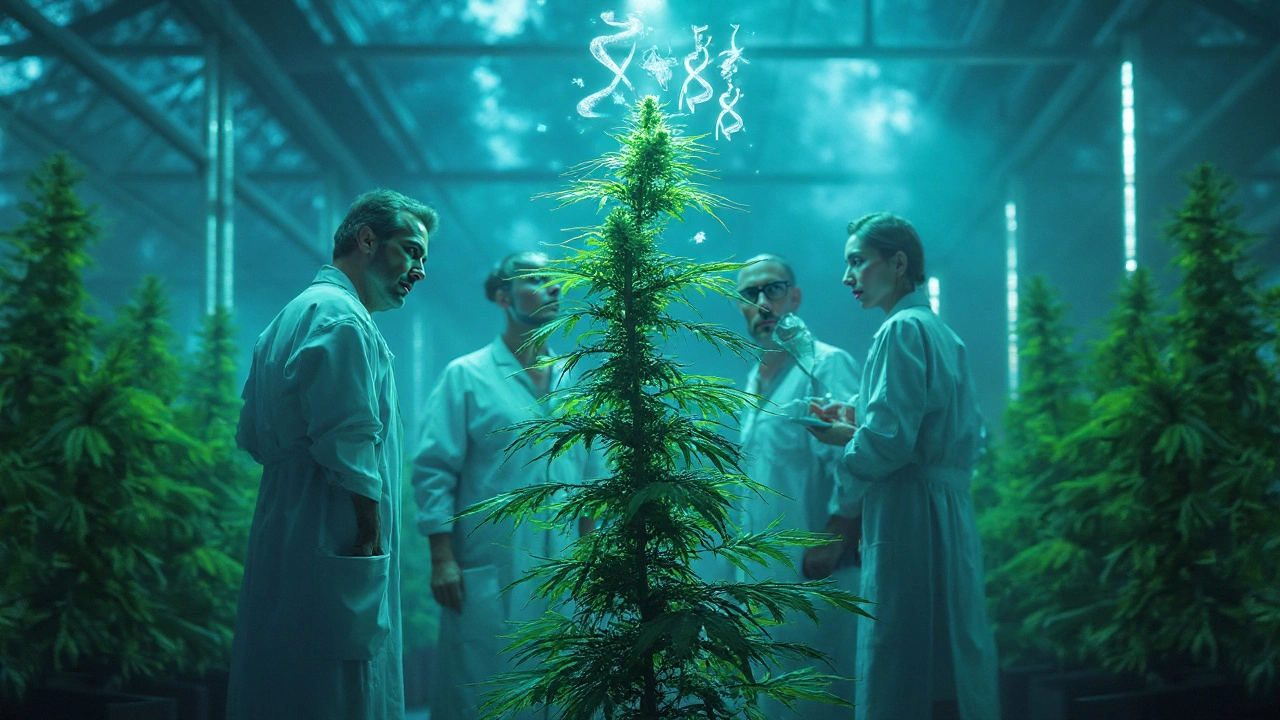
Health September 22, 2025
Famous Cannabis Strains: History, Origins & Legacy
Cannabis strain is a cultivated variety of the Cannabis plant selected for specific cannabinoid and terpene profiles. Over centuries growers have chased particular aromas, potencies, and effects, giving rise to a family tree as tangled as any wine lineage. This guide walks you through the major milestones that turned obscure regional plants into the legendary names you see on dispensary menus today.
Early Landrace Strains: The Roots of Modern Classics
Before the term “strain” entered the lexicon, growers relied on natural selection in isolated valleys and mountain ranges. These landrace plants are the genetic bedrock of today’s hybrids.
Afghan Kush is an Indica landrace from the Hindu Kush mountains, prized for deep, sedative body effects and a resin‑rich flower. First documented by Western explorers in the 1970s, Afghan Kush typically tests at 15‑20% THC and contains a soothing terpene profile dominated by myrcene.
Another powerhouse, Acapulco Gold is a Sativa landrace native to the hills surrounding Acapulco, Mexico, known for its golden pistils and euphoric, cerebral high, emerged in the 1960s U.S. counterculture. Its THC levels hover around 18% with a bright citrus aroma driven by limonene.
From the south, Panama Red is a Sativa strain that flourished in Panama’s tropical lowlands, celebrated for a vibrant red hue and an energetic, creative buzz. Though largely disappeared by the 1990s, its genetics live on in many modern hybrids.
Across the Indian Ocean, Thai Sativa is a Landrace from Thailand’s northern highlands, offering a sweet, spiced flavor and a clear‑headed, uplifting effect. Thai's low CBD content (under 0.5%) makes it a classic “head‑high” candidate for cross‑breeding.
The 20th‑Century Cross: From Counterculture to Commercial Breeding
As global travel expanded, seed traders began mixing these pure landraces. The goal was to stabilize yields, boost potency, and create new sensory experiences.
One of the first successful hybrids was Skunk #1 is a Hybrid created in the 1970s by crossing Afghan Kush with Acapulco Gold and a Colombian sativa, delivering a pungent, “skunky” aroma and balanced high. With THC levels climbing to 20‑23%, Skunk #1 set the template for modern commercial breeding.
From Skunk’s genetic pool came White Widow is a Hybrid born in the Netherlands in 1994 by pairing a Brazilian sativa with a South Indian indica, famous for its frosty trichomes and a potent, euphoric buzz. White Widow quickly became a staple of European seed banks and later inspired countless off‑shoots.
In the early 2000s, U.S. breeders fused Californian sensibilities with classic Indo‑Asian genetics, resulting in OG Kush is a Hybrid allegedly derived from Chemdawg and a mysterious “Hindu Kush” lineage, noted for its deep pine aroma and strong, relaxing body high. OG Kush’s THC often exceeds 25%, making it a benchmark for potency.
Modern Icons: The Rise of Boutique and Celebrity Strains
With legalization spreading across North America and Europe, boutique growers began branding strains as lifestyle products.
Girl Scout Cookies is a Hybrid that first surfaced in California’s Bay Area around 2010, blending OG Kush with Durban Poison, known for its sweet, earthy flavor and a powerful, full‑body relaxation. THC often reaches 28%.
Blue Dream is a Hybrid created in the 2000s by crossing Blueberry (indica) with a Sativa Haze, offering a balanced cerebral lift and gentle body relaxation. It quickly became a bestseller in Colorado, with THC levels around 18‑24%.
These strains illustrate how modern breeding merges the heritage of landraces with consumer‑driven flavor and effect profiles.
Genetics, Terroir, and the Science of Aroma
Every famous strain carries three core genetic markers: its dominant species (Indica, Sativa, Hybrid), its cannabinoid ratio (THC vs. CBD), and its terpene fingerprint. Terpenes like myrcene, limonene, and caryophyllene dictate flavor and modulate the high.
For example, Afghan Kush’s high myrcene content contributes to its “couch‑lock” feeling, while Acapulco Gold’s limonene drives a bright, uplifting buzz. The interplay between genetics and growing environment-soil composition, altitude, and light cycles-creates the famed notion of “terroir” that wine lovers know well.
Comparison of Iconic Strains
| Strain | Year Introduced | Origin | THC % (typical) | Dominant Type |
|---|---|---|---|---|
| Afghan Kush | 1970s | Hindu Kush, Afghanistan | 15‑20 | Indica |
| White Widow | 1994 | Netherlands (Brazilian × South Indian) | 18‑22 | Hybrid |
| OG Kush | Early 2000s | California, USA (Chemdawg × Hindu Kush?) | 22‑25+ | Hybrid |
| Girl Scout Cookies | 2010 | California, USA (OG Kush × Durban Poison) | 25‑28 | Hybrid |
| Blue Dream | 2000s | Colorado, USA (Blueberry × Haze) | 18‑24 | Hybrid |
Seeing these numbers side by side reveals how potency has risen dramatically since the 1970s, while the geographic spread widened from remote mountain valleys to California’s indoor farms.
Culture, Media, and the Mythic Status of Strains
Each strain carries stories that extend beyond chemistry. Afghan Kush became a symbol of the 1970s “hippie” movement, while Girl Scout Cookies turned into a pop‑culture badge of West Coast luxury. Movies, music lyrics, and even high‑fashion campaigns reference these names, turning a plant into a brand.
These cultural narratives feed back into breeding decisions: growers chase the “OG” label because consumers associate it with prestige, prompting a cascade of “OG‑inspired” hybrids that may share only a distant genetic link.
Future Directions: How New Technologies Are Shaping Strain Development
Genomic sequencing now lets breeders pinpoint single‑gene markers for THC synthase, CBD synthase, and terpene synthases. Coupled with CRISPR‑style editing (still experimental in many jurisdictions), the next generation of strains could be engineered for precise medical ratios, such as a 1:1 THC‑CBD profile for neuropathic pain.
Meanwhile, climate‑controlled vertical farms are decoupling terroir from geography, enabling identical chemotypes year‑round. Yet many connoisseurs argue that the “story” behind a strain-its regional heritage and the hands that cultivated it-remains irreplaceable.
Related Concepts and Next Steps for Curious Readers
Understanding strain history opens doors to adjacent topics like cannabinoid pharmacology, the legal evolution of cannabis markets, and the science of entourage effects. If you want to dive deeper, explore:
- The role of terpenes in therapeutic outcomes.
- How seed banks preserve landrace genetics.
- Legal frameworks shaping breeding rights across continents.
Each of these areas builds on the foundation laid by the iconic strains we’ve discussed.

Frequently Asked Questions
What makes a cannabis strain “famous”?
A strain gains fame through a mix of potency, unique flavor, cultural exposure, and the story of its origin. Media coverage, seed‑bank distribution, and consumer demand cement its status.
How reliable are THC percentages listed for classic strains?
Older landrace reports often lack lab verification, so numbers can vary widely. Modern testing standards provide more consistent data, but environmental factors still cause fluctuation.
Can I trace my favorite strain back to a specific landrace?
Many modern hybrids retain a clear lineage tag. For instance, White Widow’s pedigree lists a Brazilian sativa and South Indian indica, letting enthusiasts follow the genetic thread.
Do terpene profiles stay consistent across generations?
Terpenes are more sensitive to growing conditions than cannabinoids. While genetics set the potential, factors like soil, lighting, and harvest timing can shift the final profile.
What role does “terroir” play in modern indoor cultivation?
Indoor growers can mimic terroir by adjusting nutrients, humidity, and light spectra. Some boutique farms deliberately recreate high‑altitude conditions to echo classic landrace characteristics.
Whether you’re a seasoned connoisseur or a curious newcomer, the tale of these strains shows that cannabis is as much about heritage and culture as it is about chemistry. Dive into the genetics, savor the stories, and enjoy the evolving world of cannabis.
Write a comment
Items marked with * are required.






12 Comments
Rekha Tiwari September 22, 2025 AT 22:46
I remember my uncle in Kerala growing something similar to Thai Sativa back in the 90s-sweet, spicy, and made you laugh at nothing. Those plants were wild, no lights, just monsoon rain and red soil. Pure magic.
Leah Beazy September 22, 2025 AT 23:38
OG Kush changed my life. Not because it was the strongest, but because it made my anxiety just... disappear. Like someone turned off a radio in my head. Still my go-to after long shifts.
Jenna Hobbs September 24, 2025 AT 09:41
I just cried reading about Acapulco Gold. My grandma used to smoke it in her garden in Guerrero when I was a kid. She’d say it made the clouds look like they were dancing. I miss those days. 🌞💜
Elliott Jackson September 25, 2025 AT 19:57
You guys are overselling these strains. Back in '98 I smoked a bag of 'Afghan Kush' that was just weed with a fancy name. THC percentages? Total marketing scam. Real growers don't need lab reports to know what's good.
Andy Smith September 27, 2025 AT 12:27
The terpene science here is actually spot-on. Myrcene isn't just about couch-lock-it's a sedative synergist that enhances THC's binding affinity at CB1 receptors. Limonene, meanwhile, modulates serotonin uptake. This isn't folklore; it's pharmacology. And yes, terroir matters: a 2021 study in Plant Physiology showed soil microbiome variation alone altered terpene profiles by up to 40% in controlled grows. The 'story' isn't romantic-it's biochemical.
McKayla Carda September 29, 2025 AT 05:20
Blue Dream is the only strain I’ll ever need.
John Villamayor September 30, 2025 AT 01:05
Skunk #1 was the OG OG. I remember smoking it in a van in Vermont with no windows and thinking I’d died and gone to a very loud heaven. No fancy branding. Just pure, stanky, life-changing weed.
Ophelia Q September 30, 2025 AT 06:43
I love how Girl Scout Cookies got its name from a kid selling cookies door-to-door to fund his grow. That’s the real American dream. 🍪✨
Robert Gallagher October 1, 2025 AT 13:13
People forget that Thai Sativa was the original party strain. You’d smoke it at a rave in '93 and suddenly you’re dancing for eight hours straight while your friends just stare at the ceiling. No one knew why. Now we do. It’s the terpenes. And the lack of CBD. Pure sativa fire. I still grow a clone of it in my basement. Best thing I’ve ever cultivated.
Howard Lee October 3, 2025 AT 07:29
The fact that we’re now engineering strains with CRISPR is wild. But I hope we never lose the chaos of landraces. Nature doesn’t optimize for profit. It just survives. And sometimes, that’s when the magic happens.
Stacy Reed October 4, 2025 AT 09:46
You all talk about terroir like it’s sacred, but isn’t that just a fancy way of saying ‘I like the idea of dirt’? Modern farms produce more consistent, potent, and safer products than some backwoods grower with a bucket of compost and a prayer. Progress isn’t betrayal-it’s evolution.
Christopher Ramsbottom-Isherwood October 5, 2025 AT 23:34
Girl Scout Cookies? More like Girl Scout Con. Every ‘boutique’ strain is just a rebrand of something from the 90s. And don’t get me started on ‘OG’-it’s become the cannabis equivalent of ‘artisanal’ on a $12 bag of chips.